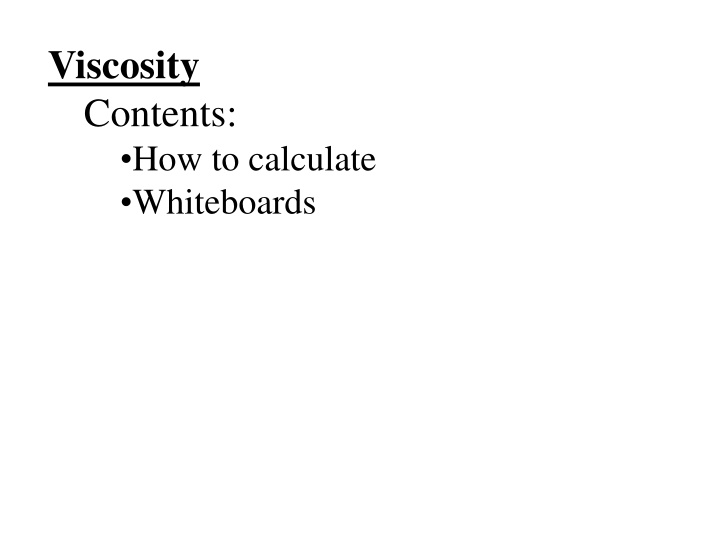
Viscosity Calculations and Properties
Learn how to calculate viscosity, understand the factors affecting viscosity such as force and area, and explore examples like Stokes's Law and Reynolds number in fluid dynamics. Discover the relationships between viscosity, force, velocity, and more in this comprehensive guide.
Download Presentation

Please find below an Image/Link to download the presentation.
The content on the website is provided AS IS for your information and personal use only. It may not be sold, licensed, or shared on other websites without obtaining consent from the author. If you encounter any issues during the download, it is possible that the publisher has removed the file from their server.
You are allowed to download the files provided on this website for personal or commercial use, subject to the condition that they are used lawfully. All files are the property of their respective owners.
The content on the website is provided AS IS for your information and personal use only. It may not be sold, licensed, or shared on other websites without obtaining consent from the author.
E N D
Presentation Transcript
Viscosity Contents: How to calculate Whiteboards
On what would the force depend? Definition of Viscosity v = F A l F = Force needed to maintain velocity (N) = Viscosity in Nsm-2 or Pas A = Area of plates in m2 l = distance separating plates in m v = velocity of the plates in m/s
Example Some students are able to move a 40.0 cm x 20.0 cm float at a constnat speed of 0.170 m/s using an applied force of 0.408 N. What is the viscosity if the distance between the float and the bottom of the container is 5.00 cm? float fluid F = Av/l, = ??? 0.408 N= (0.4 m x0.2 m )(0.17 m/s)/(.05 m) 1.50 Pa s
Stokess Law a small sphere moving through a fluid FD = Force needed to maintain velocity (N) = Viscosity in Nsm-2 or Pas r = radius of sphere in m v = velocity of the sphere in m/s Demo spray/muddy water not for large fast moving objects must be laminar flow around sphere Smooth sphere
Example A droplet of water mist ( = 1000 kg m-3) has a radius of 4.8 microns. What is its terminal velocity as it falls through air ( = 1.8x10-5 Pa s)? (ignore the buoyant force) 4/3 r3 g = 6 rv v = 0.0027904 m/s 0.0028 m/s
Reynolds number fluid in a pipe Inertial Forces Viscous forces R = Reynolds number (unitless!!!!) = Viscosity in Nsm-2 or Pas = density of fluid in kg m-3 r = radius of object or pipe in m v = velocity of the object relative to fluid in m/s When viscous forces dominate = low R = Laminar When inertia dominates = high R = Turbulent Onset of turbulence 1000 2000 Fully turbulent: 10,000 Specify which R you are using based on the length you use. (this is Re_r, there can be many different Re) Has to do with behaviour of fluid/regimes of behaviour. https://www.youtube.com/watch?v=WG-YCpAGgQQ https://www.youtube.com/watch?v=LOmQ-QLejCU https://www.youtube.com/watch?v=IDeGDFZSYo8
Example Water at 20.oC ( = 1.0x10-3 Pa s, = 1000. kg m-3) flows down an 8.0 mm diameter glass tube at 0.120 m/s. Calculate the Reynolds number to determine if the flow is laminar. What is the maximum velocity the water could have and still be laminar? (For sure set R = 1000) R = (0.120)(.0040)(1000)/(1.0x10-3) = 480 so yes it is laminar v = R /( r) = (1000) (1.0x10-3)/((1000)(.004)) = 0.25 m/s 480 yes, 0.25 m/s
Viscosity 1-5
What force is needed to move a 0.85 cm diameter marble through Karo corn syrup at 1.00 cm/s? = 2350 Pa s 6 (2350 Pa s)(.0085 m/2)(.01 m/s) = 1.8826 N 1.9 N
A water droplet has a terminal velocity of 0.00350 m/s falling through air. What is its radius? (ignore the buoyant force) Water: = 1000. kg m-3 Air: = 1.81x10-5 Pa s 4/3 r3 g = 6 rv 5.39 microns
What would be the terminal velocity of a 8.20 m diameter piece of basalt silt ( = 2920 kg m-3) sinking in water with a density of 1025 kg m-3 and a viscosity of 1.72x10-3 Pa s. (You can t ignore the buoyant force on the particle) What time would it take in minutes and seconds to settle in a test tube that is 5.40 cm tall? 4.04x10-5 m/s, 22 minutes 17 s demo centrifuge
What is the Reynolds number for a ping pong ball going through the air at 5.10 m/s? Use r = 0.0200 m. Is the flow around it laminar? (R<1000) = 1.29 kg m-3 = 1.81x10-5 Pa s R = (12.0)(.0200)(1.29)/(1.81E-5) = 7269.6 7270 so no
What is the maximum speed air could move down a 12.2 cm diameter duct and have laminar flow? (R < 1000) = 1.29 kg m-3 = 1.81x10-5 Pa s v = (1000)(1.81E-5)/{(.061)(1.29)} 0.230 m/s
Example Problem 50: (II) A viscometer consists of two concentric cylinders, 10.20 cm and 10.60 cm in diameter. A particular liquid fills the space between them to a depth of 12.0 cm. The outer cylinder is fixed, and a torque of 0.024 mN keeps the inner cylinder turning at a steady rotational speed of 62.0 rev/min. What is the viscosity of the liquid? F = Av/l, = ??? F = /r = (0.024 mN)/(.051 m) = 0.470588 N A = (2 r)h = (2 (0.051))(0.12m) = 0.038453 m2 v = r = {(62x2x rad)/(60 sec)}(0.051 m) = 0.3311 m/s l = (10.60 cm 10.20 cm)/2 = 0.20 cm = 2.0E-3 m = Fl/(Av) = 0.0739178 Pa s 0.0739 Pa s
